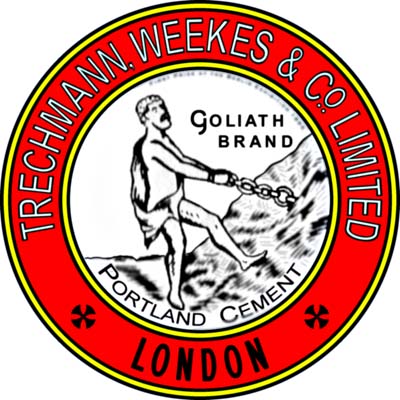
| Trechmann, Weekes & Co Goliath Brand. |
Location:
- Grid reference: TQ70876617
- x=570870
- y=166170
- 51°22'8"N; 0°27'17"E
- Civil Parish: Cuxton, Kent and Halling, Kent. Most of the plant, including the kilns, was in Cuxton.
Clinker manufacture operational: 1855-1915, 1920-1921
Approximate total clinker production: 1.36 million tonnes
Raw materials:
- Middle Chalk (New Pit Chalk Formation: 90-92 Ma) from 570400,166100
- Medway Alluvial Clay
Ownership:
- 1855-1865 Boorman, Wild and Co.
- 1865-1875 T. M. Wild and Co.
- 1875-1892 T. and W. Weekes and Co.
- 1892-1911 Trechmann, Weekes and Co. Ltd
- 1911-1921 BPCM (Blue Circle)
This was often called Whorns Place, Halling or Trechmann Weekes Works. Otto Trechmann & Co called it Medway Works. Lime and Roman cement were previously made, and Portland cement production was first advertised in August 1855. By 1869 there were seven bottle kilns of which perhaps six were used for cement, making 180 t/week. In 1876, five more bottle kilns (150 t/week) were added, and another eight (240 t/week) in 1881. The first three chamber kilns were installed around 1884, and the block was extended to fifteen around 1888. Around 1891 two pairs of Dietzsch kilns were added and the bottle kilns were abandoned. A further seven chamber kilns were added around 1899, bringing the total capacity to 600 t/week chamber and 200 t/week Dietzsch. This corresponds with Davis’ 1907 capacity. The company was part of the APCM amalgamation in 1900, but dropped out.
Apparently because O. K. Trechmann had been offered part-payment in cash, but in the event APCM could not afford this, and Trechmann withdrew. APCM sued him for £15,000, but settled in 1905 for £500. (JHE 24/10/1907 interview with O.K.Trechmann)
Unlike West Kent which was in a similar situation, the plant was not sufficiently profitable to expand much. Around 1907, four Schneider kilns (400 t/week, 9.5 MJ/kg) were installed and the Dietzsch kilns were stopped, bringing capacity to 1000 t/week. Shut down in 1915, the kilns were briefly reinstated in 1919-1921: the 1920 registered output was 1000 t/week. The remains of the plant were described in the BPCM 1924 schedule. The plant had a siding on the Medway Valley railway from its inception, but probably used water for the majority of its transportation. After closure, the site was cleared, and is now waste land, as is the partially land-filled quarry.
Power supply
Raw- and finish-mills were direct-driven from a central 550 HP double-expansion steam engine. After 1900, gas engines were used as a light duty back-up. Electricity generated by gas engine was used only for lighting and for the Schneider pressurisation fans.
Rawmills
The chamber kiln plant used a rough- and an intermediate washmill, followed by a set of ?3 pairs of flat stones.
No rotary kilns were installed.
Sources:
- Primary Sources:
- Greenhithe Archive
- BPCM 1924 schedule
- Ordnance Survey 1:2500 mapping
- BGS mapping and monographs
- Confirmatory Sources: